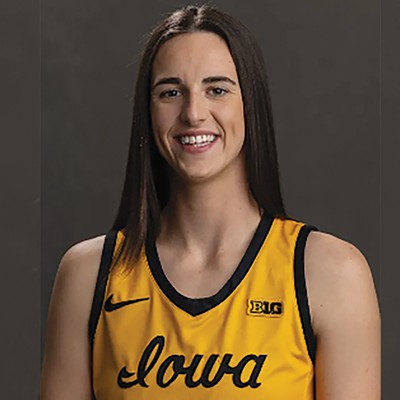Indian reservations in this country deal with a duality in that they are sovereign nations inside another nation (or, in the case of the Tohono O'odham, straddling two other nations).
For a long time, that duality worked against them, but after the turbulent 1960s and '70s, and with the help of some justifiably favorable court rulings, it now works in their favor, at least in some ways. Being different is now celebrated, and being independent is leading to economic power.
Nowhere is the stark difference between life on and off the reservation more delightfully evident and more openly celebrated than in the arena of high school basketball. Where prep basketball in most of Arizona is a moderately popular winter sport wedged in between moderately popular football in the fall and moderately popular baseball and softball in the spring, basketball on Indian reservations is nonstop excitement, with packed houses, rabid fans and players who approach the game with an almost-religious fervor.
Across the Navajo and Hopi nations that occupy the northeast quadrant of the state, down through the Apache reservations, and even into the Tohono O'odham and Yaqui reservations in the Southwest, basketball is king, basketball is life.
The Arizona Interscholastic Association, which governs high school sports in Arizona, presented the Class 3A state championships last week in Glendale. Class 3A schools are midsize, at best, generally in the 450-900 range in enrollment. Many of the bigger schools in Phoenix and Tucson approach and surpass 3,000 in enrollment. But whereas the championship games for the big schools could probably be held in a large high school gymnasium, the 3A games, by necessity, have to be held in a giant arena.
(Of course, the AIA, which could probably screw up an orgasm, is taking a sledgehammer to the whole process next year. In what they claim is a cost-saving measure, though it appears to be to a work-saving measure for the AIA, the number of teams and athletes that will get to experience postseason play will be severely slashed.)
For now, however, crowds of 10,000 or more are the norm for state games involving reservation teams, and so it was when Monument Valley and Window Rock squared off for the 3A girls' championship.
A couple of weeks earlier, Fort Thomas, an Apache school, was in the Class 1A (small schools) girls' state tournament in Prescott. Since the AIA, in its finite wisdom, chooses to hold that tournament in a relatively remote location starting on a Friday morning, the early games are usually sparsely attended. However, when I went to Prescott High School to watch Fort Thomas later in the day, I got there just as the four tour buses were disgorging the Apache (that's both their ethnicity and their school mascot, and thus far, no PC do-gooders have demanded a change) fan base.
The fans waiting to get in were funneled through a narrow hallway with only one ticket-taker, making it a half-hour wait to get in the gym. Ahead of me in line were about 150 Fort Thomas faithful, with another couple hundred or so behind me. That's nearly three times as many fans as kids in the school.
While standing in line, I looked ahead and looked behind, and told the guy next to me, "I look like the answer to the question, 'What's wrong with this picture?'"
Fort Thomas made it all the way to the state championship game the following weekend, and the fan-filled tour buses made the trip again, this time into the teeth of a snowstorm that blanketed the Prescott area. At halftime of the Apaches' game with Gilbert Christian, the AIA welcomed back the 25th anniversary championship team that also happened to be from Fort Thomas.
Sharon Waterman, who was on that 1986 championship team, has witnessed the evolution of the game firsthand. "We were just a bunch of girls who wanted to do something special. We told coach (Barbara Stauffer) when we were in the seventh-grade that we were going to be champions, and we were. We won the state volleyball championship and the basketball championship."
Waterman has had a couple of sons star on Fort Thomas teams over the past few years and marvels at the game's growth. "It's really amazing," she says. "You can't go anywhere on the reservation without seeing a basketball hoop in the driveway or the backyard or even out in the middle of nowhere. Basketball is part of our culture."
Waterman's teammate, Rozanna Anderson, sees it as mostly a good thing. "It gives kids something to do. You want kids to have a positive outlet. But it gets out of hand sometimes."
Fort Thomas has stopped playing against Class 2A San Carlos, which is part of the same huge Apache reservation. "We'd go down there, and after the game—win or lose—they'd egg our bus or throw rocks. It got ugly, so we stopped."
Both women agree that, for the most part, Native crowds are knowledgeable, well-behaved and wildly enthusiastic.
Back at the 3A championships, I talked to Candace Begody, who covers sports for the Navajo Times, a popular publication on the Navajo reservation that sprawls over parts of Utah, New Mexico and Arizona. A year ago, she was a senior at the University of Arizona, finishing up degrees in journalism and Native American studies. She was a recipient of the Morris K. Udall Foundation scholarship and Miss Native American UA as well. She is a native of Cross Canyon and is of the Honey Combed Rock People Clan born for the Bitter Water Clan (which makes one want to go back and read all of those Tony Hillerman novels to get an idea of what that actually means).
Begody played a little basketball at Ganado High School, but mostly did cross country and track. She knew that basketball was king on the rez, but wasn't completely aware of its scope.
The 18,300-seat Jobing.com Arena in Glendale is about one-quarter full of fans more than an hour before the start of the day's first game, a 3A girls' semifinal contest between Monument Valley and Tuba City. More than 95 percent of those fans are Native Americans. Looking out over the arena as the fans continued to file in (the lines at the ticket windows outside were all at least 20 deep), Begody smiles. "It's really amazing, the fan support. These people think nothing of traveling hundreds of miles to support their teams."
(When the AIA had held the 3A quarterfinals earlier in the week at Tim's Toyota Center in Prescott Valley, they did so in two sessions—afternoon and evening—so they could empty out the building and charge another admission for the night games. Native fans are known for their ability to sit in a gym for 10 to 12 hours nonstop.)
Ganado High won the state girls basketball championship the year after she graduated. "I was very happy that my (alma mater) won, but I didn't realize how big of a deal it was. Traveling around the entire reservation now, covering sports, I find that there are people in remote parts of the reservation who know all about that team and about all of the teams. It's really a cultural phenomenon for the Navajos, as I'm sure it is for other Native peoples."
Rez ball, as it is affectionately and reverentially referred to by many (and derisively by some), first burst onto the national scene in a classic 1991 Sports Illustrated article by Gary Smith titled "Shadow of a Nation." It told of a nearly mythic Crow basketball player with the wondrous name of Jonathan Takes Enemy, who led his Hardin High School team to a Montana state championship. But within several years of winning the title, two of Takes Enemy's teammates—Jo Jo Pretty Paint and Darren Big Medicine—had died in single-car drunk-driving crashes, while two others—Miles Fighter and Everette Walks, both fatherless and both having lost mothers to cirrhosis—would end up drinking heavily with no discernible futures. For his part, the tragically heroic Takes Enemy would bounce around from girl to oh-so-willing girl and from college team to college team until his string (and eligibility) ran out.
It should have been a cautionary tale, but, if anything, it placed a spotlight on what was emerging as a national phenomenon: Interest in basketball on Indian reservations has grown exponentially in the 20 years since the SI article.
The crowd surges past the 5,000 mark as game time approaches. There may be 200 to 300 non-Natives in the building.
A couple of years ago, Tucson Ironwood Ridge's boys' team was playing the 5A-II (big schools) state semifinals at Jobing.com. There may have been 1,500 people in the building for that game, and some of the IR fans wondered aloud why the 5A game was being played at noon, and the games involving the smaller 3A schools were being played at more-prominent later times. It soon became evident. As the second 5A semifinal game was being played, the place started filling up. By the time the first 3A girls' semifinal game began, there were probably 10,000 people in the building. By the time it was over, it was up to 13,000. The Jobing folks eventually had to open up the top nosebleed sections to handle the near-capacity crowd.
It is a testament to the Native fans that the enthusiasm for the boys' and girls' teams is virtually equal. With a few glaring but rare exceptions, there isn't a great height differential among girls' teams across the state, and reservation girls' teams dominate the 3A, year in and year out. In the past 22 years, only Springerville Round Valley (in 2003) and Snowflake (in 1991 and 1997) have broken the stranglehold that Navajo and Hopi teams have on the 3A girls' title. Window Rock won five straight titles from 1992 to 1996, and Tuba City grabbed three straight from 2000 to 2002. Monument Valley won it two years ago, and Window Rock was last year's runner-up, so there was plenty of experience on the court.
On the boys' side, height is often a determining factor. While 17 Native teams have played in the 3A finals in the past 20 years, the title is most often won by a small-town power like Globe or Coolidge that happens to string together a couple of really athletic classes, or by an up-and-coming school that is passing through 3A on its way to big-school status.
Because most 3A schools are located in remote areas, the urge and opportunity to cheat doesn't arise very often. It would be difficult for stage-mother/jock-father parents to shop their kids around from one end of the reservation to the other, and there's also a deep-roots aspect to reservation life. A Window Rock kid doesn't want to play for Ganado, and a Chinle kid doesn't want to slip across the state line and play for Shiprock, N.M.
The win-at-all-costs mentality that is eating away at the foundation of prep sports in Arizona and America has seeped down from the large schools into the small schools, mostly bypassing Class 3A in the process. This year's 1A (small-school) boys' champion is a boarding school whose starters hailed from four different foreign countries, while the 2A boys' championship team looked like a squad from the NBA Development League. The coach who assembled that squad must think that "Shame on you!" has replaced the former common greeting of "Hello."
There is also a 1A girls' squad whose coach treats rules against recruiting like some people treat speed limits—like they're merely suggestions rather than actual laws. The school's program is a pariah, especially among other Native teams and coaches that have a fear of guilt by association.
As tip-off for the girls' game nears, Ben Begay returns from the snack bar and settles into his front-row seat. He's wearing a Slipknot shirt that we can only assume was a gift from a blind person. When asked who he wants to win, he shrugs, "I'm mostly a Chinle fan, but they lost to Tuba City in the second round ... ." He doesn't finish his thought.
Chinle is home to the coolest high-school basketball arena in the Southwest, the Wildcat Den. Where else are you going to find a school with around 500 students with a basketball facility that seats 6,000? The facility was financed in-house and is already paid off. Officials estimate that they take in around $15,000 in ticket sales and another $10,000 in concessions at every home game! When Chinle hosted the regional tournament in mid-February, tickets were being scalped for three figures.
Every seat on both long sides of the Jobing.com Arena is filled, and the seats in the end zones are starting to be filled in as the Monument Valley-Tuba City game begins. For long stretches of the first half, the game has all the excitement of an oral-hygiene lecture. Yet still the crowd makes its presence felt, clapping after every rebound, oohing at every missed shot, and whipping itself into a frenzy on the two (!) occasions when three-point shots are attempted.
This is not the Rez Ball that is either glorified or vilified, the all-out assault on the basket at break-neck pace, with full-court presses and wild three-pointers for all. Instead, it's a bone-jarring defensive battle, slow and painful, contested by what appears to be 10 nearsighted proctologists, not one of whom can find the hole.
Controlling the action at both ends of the court is Monument Valley's Bradley Nash, a long, athletic kid who brings the entire crowd to its feet by swatting a Tuba City shot over the bench and into the stands. Nash is already the state's top small-school volleyball player and has a decent shot at adding the basketball honor to her résumé as well.
The game also pits Monument Valley's Naomi Whitehair and Tylesha Yellowhair against Tuba City's Kailee Birdinground, Delight Teller and Unique Byars. I'm sorry, but that's just cool.
Thanks to several more blocked shots by Nash, Monument Valley holds Tuba City to one point in the second quarter and goes into the locker room with an (ugh) 14-10 lead. Tuba City ties the game heading into the fourth quarter, then gets outscored 13-1 in the fourth quarter.
After the game, Nash, who will be attending New Mexico State next year on a volleyball scholarship, shrugs at the size of the crowd. "We've come to expect this. It's part of who we are."
If basketball is this important, then why the volleyball scholarship?
"I like volleyball better," she says flatly.
With her father being the school's long-time basketball coach, and her mother the school's volleyball coach, who's her favorite coach?
"I used to run track in the spring, but this year, I'm playing softball."
I'm not sure whether it's a deliberate non-sequitur or if she didn't hear the question.
The Monument Valley boys then take the court against Fountain Hills in a decided mismatch. Fountain Hills has two 6-foot-9 kids, while MV's tallest player, (ahem) Shaquille Sherlock, is 6 foot 1, maybe. Monument Valley falls behind early before making several runs utilizing a full-court press and a trapping defense, but Fountain Hills brushes them aside to win by 28. Late in the game, the small but vocal Fountain Hills crowd begins the chant that is guaranteed to get every member of the band Steam a one-way ticket to hell—na na na na, hey hey hey, goodbye. They are quickly drowned out by the Monument Valley crowd that outnumbers them by at least 20-1.
The Fountain Hills players, who rode the boards to victory, later whined about Monument Valley's tenacity, claiming, in the words of starting forward Nick Baker, that "the refs didn't call anything for us." Fountain Hills shot about 35 free throws while Monument Valley shot seven. After the game, FH coach Matt Johnson shrugged derisively, "That's Rez Ball."
Next up are Window Rock's girls, with a gaudy 32-1 record, against a powerful (non-Native) Safford team. The Fighting Scouts represent what the Navajo Times calls "the capital city" and are led by Nash's main rival for the top-player honor, senior point guard Coralie Clark.
Window Rock, the eventual champion, jumped out quickly and held a double-digit lead for most of the game. Clark ran the show from the point and, after the game, credited her teammates and the fans. "We're here to win a championship. That's why we're all here."
Before the nightcap featuring the boys from Winslow and Holbrook High Schools (two quasi-rez teams), lines are forming at Jobing's ticket windows for the next day's games. I happen to spot Ben Begay on my way out.
I ask him, "Is it sacrilegious to say that basketball is like a religion on the reservation?"
"No," he smiles. "It's way more than that."











